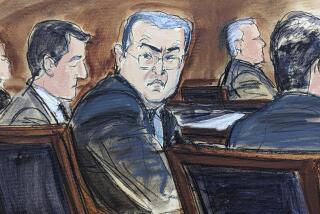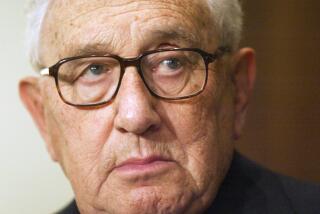What Did Negroponte Hide and When Did He Hide It?
- Share via
MANAGUA, Nicaragua — As the Senate considers the nomination of John D. Negroponte to be the U.S. ambassador to the United Nations, it is important to look at charges that, as ambassador to Honduras, Negroponte suppressed information about the Honduran military’s human rights violations. This is a serious matter. What is the evidence?
According to a 1997 CIA inspector general’s report, U.S. officials in Honduras were aware of serious violations of human rights by the Honduran military during the 1980s but did not adequately report this to Congress. A heavily redacted version of the report notes particularly that the U.S. Embassy suppressed sensitive data during Negroponte’s time there.
I am especially concerned about the disappearance of two U.S. citizens--Father James “Guadalupe” Carney and David Arturo Baez Cruz--during Negroponte’s tenure. Carney had come to Honduras in 1983 as a chaplain to a revolutionary group, which included Baez Cruz, a Nicaraguan American who had served in the U.S. special forces. The group was captured by the Honduran army, and Carney “disappeared” along with nearly all of the 96 members of the group.
U.S. officials eventually gave Carney’s chalice and stole, turned up by the Honduran army, to his relatives. But the army never explained the circumstances of the priest’s death, suggesting only that he probably starved in the mountains. Five years later, in 1988, the New York Times reported that a former officer of the Honduran army said he personally had interrogated Carney. Carney’s body has not been found, and the people responsible for his death have not been identified. Whether any U.S. agents or officials were involved in his disappearance remains an open question.
In a section with repeated references to the capture and execution of Jose Maria Reyes Mata, the political leader of the group, the CIA inspector general’s report cited a source whose name has been blacked out who “believes that the embassy country team in Honduras wanted reports on subjects such as this to be benign to avoid Congress looking over its shoulders.”
Reporting murders, executions and corruption, says the source, would “reflect negatively on Honduras and not be beneficial in carrying out U.S. policy.” The embassy seemed particularly sensitive to reports about the operation in which the two U.S. citizens disappeared, the report said, quoting another source as recalling “a discussion . . . circa 1983 wherein the latter indicated that unspecified individuals at the embassy did not want information concerning human rights abuses . . . to be disseminated because it was viewed as an internal Honduran matter.” This is corroborated by an Aug. 19, 1985, handwritten memo declassified by the State Department: “Fr. Carney case . . . is dead. Front office does not want the case active. . . . We aren’t telling that to the family.”
The CIA report cites another person whose name has been deleted as explaining “the basis for no further reporting on the prisoner executions--the event had been reported previously and there was concern on the part of Negroponte that over-emphasis would create an unwarranted human rights problem for Honduras.” Among his conclusions, the CIA inspector general states: “The ambassador was particularly sensitive regarding the issue and was concerned that earlier CIA reporting on the same topic might create a human rights problem for Honduras. Based on the ambassador’s reported concerns, [blacked out] actively discouraged [blacked out] from following up the information reported by the [blacked out] source.”
It was up to members of Congress to determine whether Honduras had a human rights problem. But Negroponte denied them the facts needed for their judgment.
More to Read
Sign up for Essential California
The most important California stories and recommendations in your inbox every morning.
You may occasionally receive promotional content from the Los Angeles Times.









